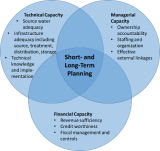Learn about Small Drinking Water Systems
More than 97% of the nation’s 156,000 public water systems are small systems, meaning they serve 10,000 or fewer people. A public water system (PWS) is a system that provides water for human consumption to at least 25 people or 15 service connections.
PWSs include:
- Municipalities
- Small towns
- Homeowners associations
- Other kinds of facilities like schools, restaurants or campgrounds
Small water systems can face unique financial and operational challenges in consistently providing drinking water that meets EPA standards and requirements. EPA works closely with states and our federal and tribal partners to assist small systems with financial and technical resources to sustainably provide safe drinking water.
On this page:
What Is Capacity Development?
Capacity Development is a process for water systems to acquire and maintain adequate technical, managerial and financial (TMF) capacity. TMF capacity enables water systems to have the capability to consistently provide safe drinking water to the public.
How Can Capacity Development Help Water Systems?
Capacity development is a fundamental component of the 1996 Safe Drinking Water Act (SDWA) Amendments. The SDWA Amendments provide a framework for states and water systems to work together to protect public health. Every state has developed a Capacity Development Program to assist public water systems in building TMF capacity.
Any water system can implement capacity development activities to increase their TMF capacity. Small systems can especially benefit from capacity development. EPA is committed to helping small water systems provide safe drinking water through publications, training, and technical and financial assistance.
Local officials and consumers play an important role in helping small water systems meet regulatory requirements and protect public health. Besides protecting public health, communities that support their water systems are making long-term investments in sustainable communities and economic well-being.


